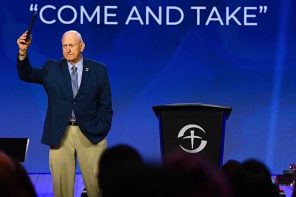The Freedom Federation Summit taking place April 15-16 at Jerry Falwell’s Liberty University in Lynchburg, Virginia was billed as the next Great Awakening, the inaugural gathering of “a new movement [that] is forming in America comprised of people of all races, ethnicities and generations.” With the mobilizing power of dozens of religious right organizations behind it, why was the first night attended by only a few hundred people?
I’m not sure what the organizers were thinking, but kicking off this thing on tax day, knowing that tea parties were mobilizing around the country, was obvious poor planning. Last night’s activities took place inside Thomas Road Baptist Church, which seats several thousand, but only drew a few hundred spectators, and when I first arrived there were only a few dozen. This could not have made many of the first night’s top speakers — including the Family Research Council’s Tony Perkins, the Southern Baptist Convention’s Richard Land, and Virginia Attorney General Ken Cuccinelli — very happy. Some of today’s activities are slated to take place in the University’s basketball arena, which seats 10,000, and it would be remarkable if Liberty and/or Thomas Road aren’t able to send out an ABP to get some more warm bodies in the place.
That the Summit conflicted with the tea parties was clearly on many speakers’ minds, and there appeared to be an ambivalence about whether to embrace the tea parties or present the Freedom Federation as an alternative to them. But given that the purpose of the Freedom Federation is to market the religious right in a new way — basically as more than just a bunch of aging white guys — some of the black speakers took up the issue of the whiteness of the tea parties, and charges of racism. Tim Johnson, the vice-chair of the North Carolina Republican Party, the first black person to hold that post, who moderated a panel, The Values, Politics, and Messaging of the Black Community, sought to dispel “rumors” that the tea party movement doesn’t “welcome blacks.” Yet while they endorsed their tea party friends (who had apparently depleted their audience), other speakers made clear that perhaps the tea parties needed a little more of the holy ghost. “We need the tea party movement with a Christian imperative,” said the Rev. Samuel Rodriguez, president of the National Hispanic Christian Leadership Conference. “That would be a movement and a revolution on steroids.”
Obviously there are plenty of religious right figures who have embraced and spoken at tea parties, including some of last night’s speakers. And while they spoke highly of their tea party friends — because who could harbor ambitions of being the next big thing in the conservative movement without doing that — they were insisting that they were something more: religious, of course, but also “multi-racial, multi-ethnic, and multi-generational.”
Since the deaths of Falwell and D. James Kennedy and the aging of other iconic religious right figures, people inside and outside the movement have pondered who would be its next leader. Last night Mat Staver, dean of Liberty’s law school, made clear that the movement is no longer about “individual voices” but that “God is deepening and widening the movement by bringing individuals with various voices. . . . That’s what unites us rather than divides us.”
The sponsoring organizations here are a combination of old guard religious right steeped in political organizing and mobilizing, like the Family Research Council, and charismatic evangelical organizations motivated not by voter lists and recruiting precinct captains but by prophecy, spiritual warfare, and creating a new generation of apostles to engage in battle and bring about revival. This alliance is long in the making — in 2008, for example, some of the same organizations teamed up to fight for Proposition 8 in California, and last year mobilized against health care reform, which they depicted as part of the “culture of death.”
The religious right is trying to find its footing in the tea party environment. It isn’t dead, by any stretch of the imagination, last night’s moribund activities here notwithstanding. Still, judging from last night’s lackluster performance, it hasn’t quite figured out how stage a revival when the tea parties have sucked all the oxygen out of the room.




